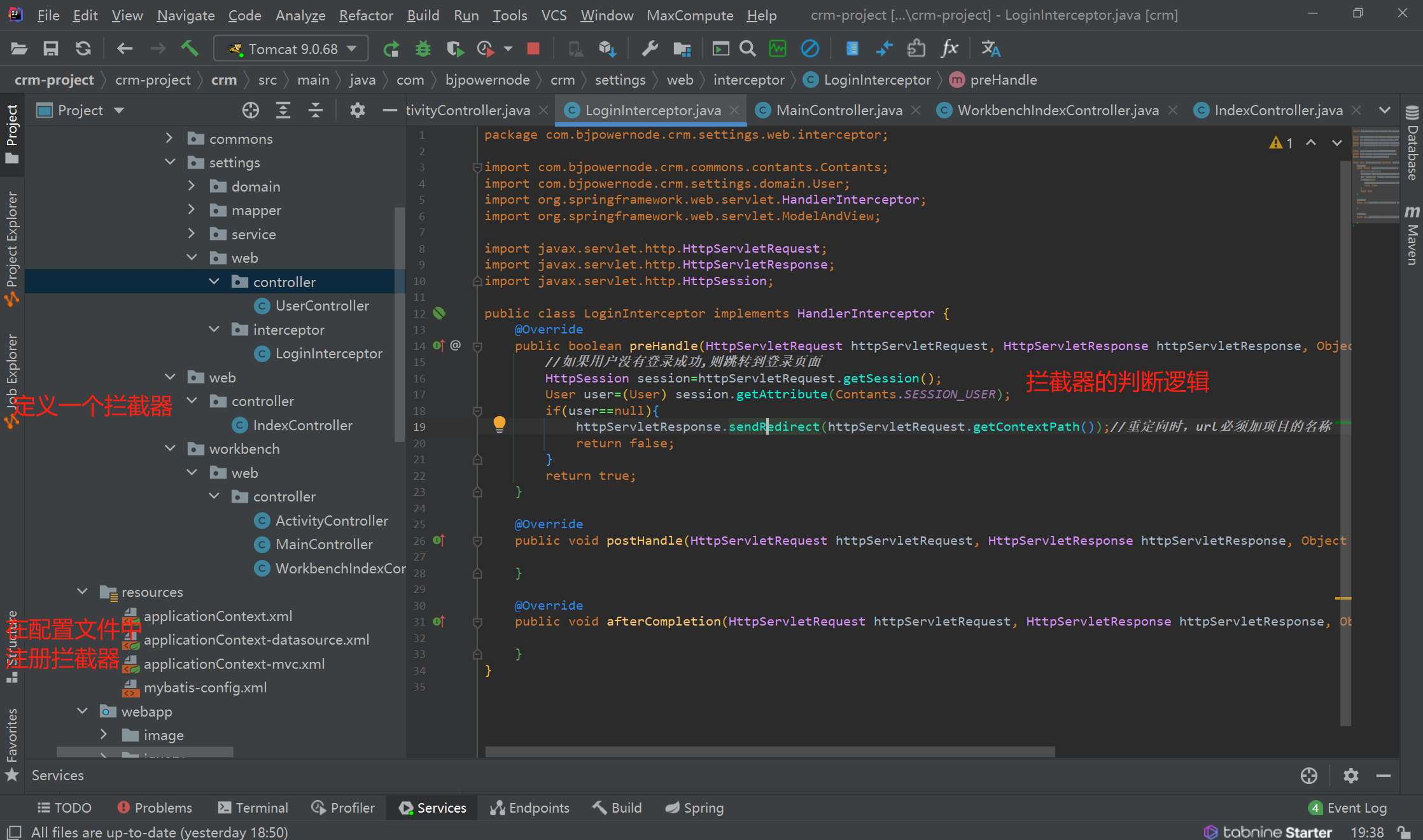第三章. 业务功能开发--登录验证(使用拦截器)
第三章. 业务功能开发--登录验证(使用拦截器)
需求
登录验证.
用户访问任何业务资源,都需要进行登录验证.
*只有登录成功的用户才能访问业务资源
*没有登录成功的用户访问业务资源,跳转到登录页面
结构:

1.拦截器
-
定义一个拦截器:
package com.bjpowernode.crm.settings.web.interceptor; import com.bjpowernode.crm.commons.contants.Contants; import com.bjpowernode.crm.settings.domain.User; import org.springframework.web.servlet.HandlerInterceptor; import org.springframework.web.servlet.ModelAndView; import javax.servlet.http.HttpServletRequest; import javax.servlet.http.HttpServletResponse; import javax.servlet.http.HttpSession; public class LoginInterceptor implements HandlerInterceptor { @Override public boolean preHandle(HttpServletRequest httpServletRequest, HttpServletResponse httpServletResponse, Object o) throws Exception { //如果用户没有登录成功,则跳转到登录页面 HttpSession session=httpServletRequest.getSession(); User user=(User) session.getAttribute(Contants.SESSION_USER); if(user==null){ httpServletResponse.sendRedirect(httpServletRequest.getContextPath());//重定向时,url必须加项目的名称 return false; } return true; } @Override public void postHandle(HttpServletRequest httpServletRequest, HttpServletResponse httpServletResponse, Object o, ModelAndView modelAndView) throws Exception { } @Override public void afterCompletion(HttpServletRequest httpServletRequest, HttpServletResponse httpServletResponse, Object o, Exception e) throws Exception { } } -
注册拦截器
注意哪些应该拦截,哪些不应该拦截。拦截成功之后往哪里跳转。
<?xml version="1.0" encoding="UTF-8"?> <beans xmlns="http://www.springframework.org/schema/beans" xmlns:xsi="http://www.w3.org/2001/XMLSchema-instance" xmlns:context="http://www.springframework.org/schema/context" xmlns:p="http://www.springframework.org/schema/p" xmlns:util="http://www.springframework.org/schema/util" xmlns:aop="http://www.springframework.org/schema/aop" xmlns:tx="http://www.springframework.org/schema/tx" xmlns:mvc="http://www.springframework.org/schema/mvc" xsi:schemaLocation=" http://www.springframework.org/schema/beans http://www.springframework.org/schema/beans/spring-beans.xsd http://www.springframework.org/schema/context http://www.springframework.org/schema/context/spring-context.xsd http://www.springframework.org/schema/tx http://www.springframework.org/schema/tx/spring-tx.xsd http://www.springframework.org/schema/aop http://www.springframework.org/schema/aop/spring-aop.xsd http://www.springframework.org/schema/mvc http://www.springframework.org/schema/mvc/spring-mvc.xsd http://www.springframework.org/schema/util http://www.springframework.org/schema/util/spring-util.xsd"> <!-- dispatcherServlet截获所有URL请求 --> <mvc:default-servlet-handler /> <!-- spring mvc 扫描包下的controller --> <context:component-scan base-package="com.bjpowernode.crm.web.controller"/> <context:component-scan base-package="com.bjpowernode.crm.settings.web.controller"/> <context:component-scan base-package="com.bjpowernode.crm.workbench.web.controller"/> <!-- 配置注解驱动 --> <mvc:annotation-driven/> <!-- 配置视图解析器 --> <bean id="viewResolver" class="org.springframework.web.servlet.view.InternalResourceViewResolver"> <property name="prefix" value="/WEB-INF/pages/"/> <property name="suffix" value=".jsp"/> </bean> <mvc:interceptors> <mvc:interceptor> <!--配置拦截的请求--> <mvc:mapping path="/settings/**"/> <mvc:mapping path="/workbench/**"/> <!--配置排除拦截的请求(优先级高)--> <mvc:exclude-mapping path="/settings/qx/user/toLogin.do"/> <mvc:exclude-mapping path="/settings/qx/user/login.do"/> <!--拦截器类--> <bean class="com.bjpowernode.crm.settings.web.interceptor.LoginInterceptor"/> </mvc:interceptor> </mvc:interceptors> <!-- 配置文件上传解析器 id:必须是multipartResolver--> <!--<bean id="multipartResolver" class="org.springframework.web.multipart.commons.CommonsMultipartResolver"> <property name="maxUploadSize" value="#{1024*1024*80}"/> <property name="defaultEncoding" value="utf-8"/> </bean>--> </beans>
2. 总结:拦截器,页面切割技术,模态窗口
1,登录验证:
1)过滤器:
a)implements Filter{
--init
--doFilter
--destroy
}
b)配置过滤器:web.xml
2)拦截器:
a)提供拦截器类:implements HandlerInterceptor{
--pre
--post
--after
}
b)配置拦截器:springmvc.xml
2,页面切割技术:
1)<frameset>和<frame>:
<frameset>:用来切割页面.
<frameset cols="20%,60%,20%" rows="10%,80%,10%">
<frame>:显示页面.
<frame src="url">
<frameset cols="20%,60%,20%">
<frame src="url1" name="f1">
<frame src="url2" name="f2">
<frame src="url3" name="f3">
</frameset>
每一个<frame>标签就是一个独立的浏览器窗口。
<a href="url" target="f3">test</a>
2)<div>和<iframe>:
<div>:切割页面。
<div style="height:10%;width=20%">
<iframe>:显示页面。
<div style="height:10%;width=20%">
<iframe href="url">
</div>
3,创建市场活动:
模态窗口:模拟的窗口,本质上是<div>,通过设置z-index大小来实现的;
初始时,z-index初始参数是<0,所以不显示;
需要显示时,z-index值设置成>0即可。
bootstrap来控制z-index的大小。
控制模态窗口的显示与隐藏:
1)方式一:通过标签的属性data-toggle="modal" data-target="模态窗口的id"
2)方式二:通过js函数控制:
选择器(选中div).modal("show");//显示选中的模态窗口
选择器(选中div).modal("hide");//关闭选中的模态窗口
3)方式三:通过标签的属性data-dismiss=""
点击添加了data-dismiss=""属性的标签,自动关闭该标签所在的模态窗口。
模态窗口的意义:
window.open("url","_blank");
模态窗口本质上就是原来页面中的一个<div>,只有一个页面;所有的操作都是在同一个页面中完成。



 浙公网安备 33010602011771号
浙公网安备 33010602011771号